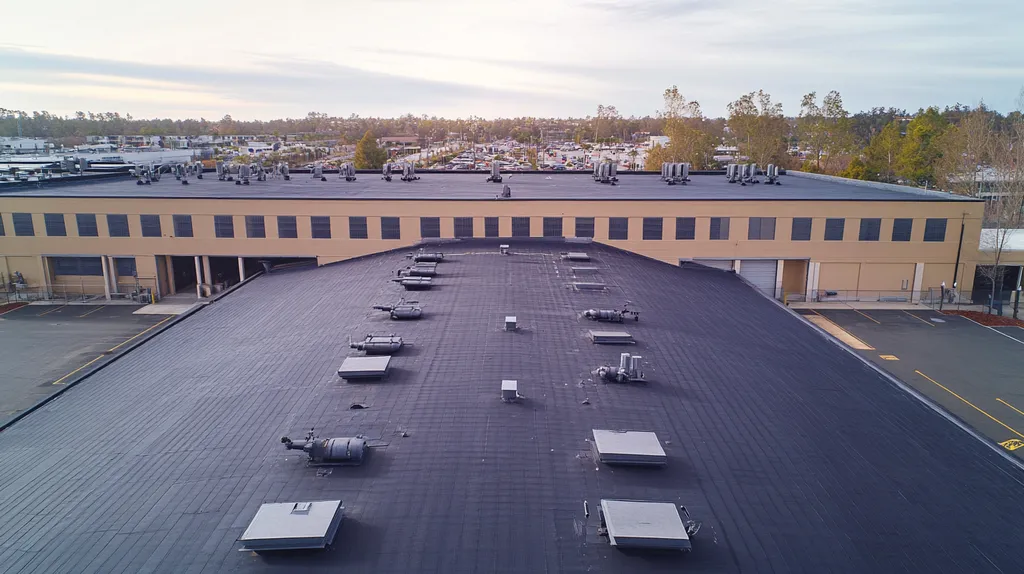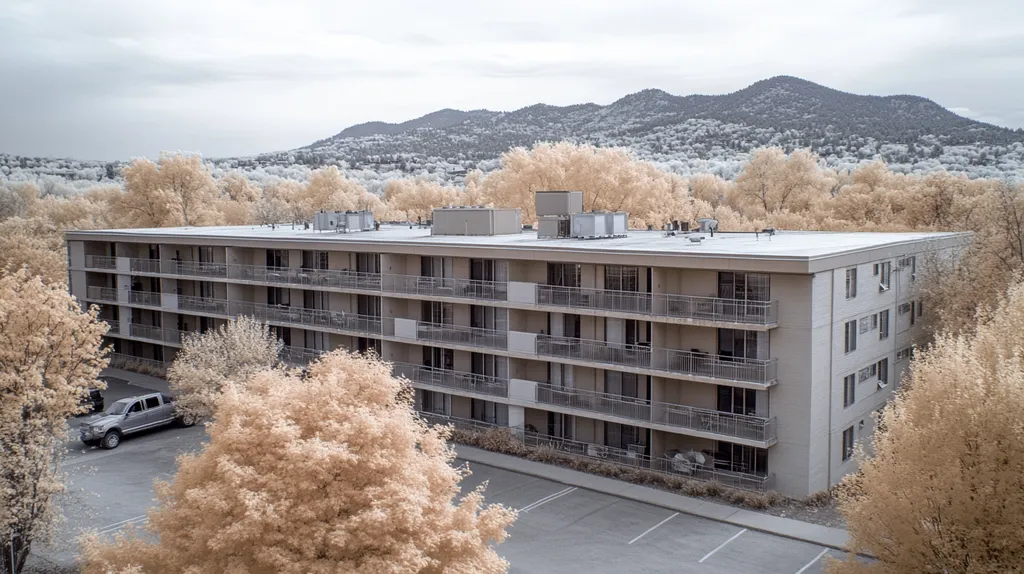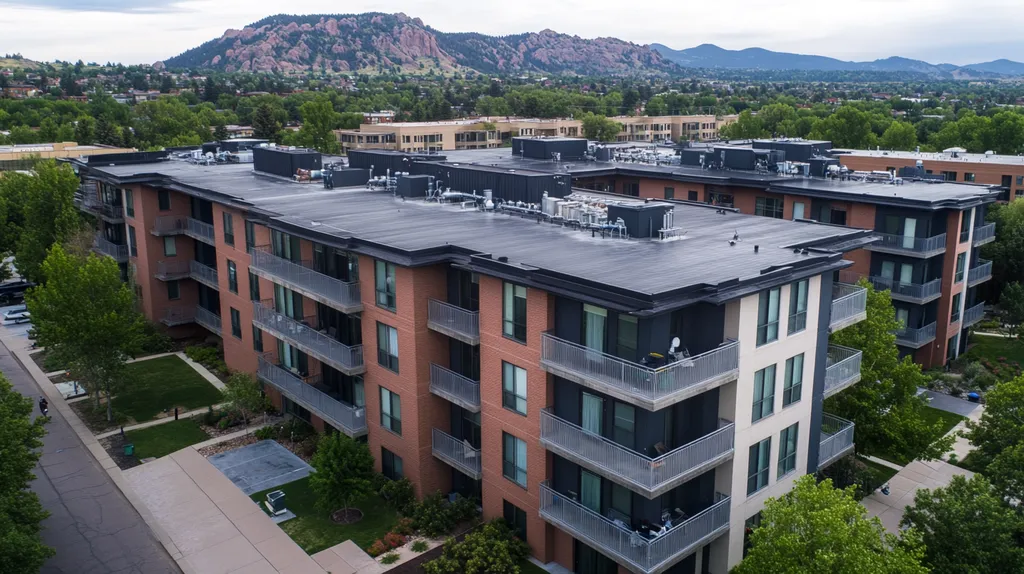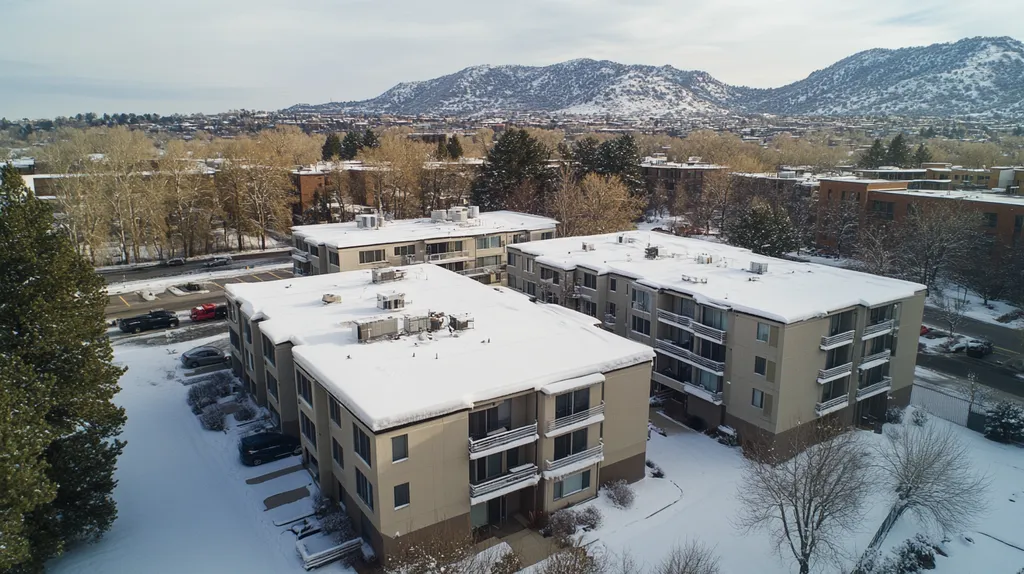Commercial property owners face a critical decision when selecting roof coatings, with studies showing improper choices can reduce building energy efficiency by up to 40% while accelerating structural deterioration.
From solar reflectance ratings to chemical compatibility requirements, the complexity of modern coating systems demands careful evaluation across multiple performance factors.
This comprehensive guide examines the key considerations property professionals must weigh when specifying roof coatings, including energy performance metrics, financial implications, and regulatory compliance standards.
SECTION 1: PERFORMANCE FACTORS
Selecting the right roof coating is not just a cosmetic choice; it can profoundly influence a building’s energy efficiency and durability. As commercial property owners grapple with rising energy expenses and a push for sustainability, understanding the role of roof coatings becomes essential. Research indicates that high-reflectance coatings can cut cooling costs by up to 30%, highlighting the importance of solar reflectance, thermal emittance, and durability in making smart decisions.
Solar Reflectance and Thermal Emittance
Solar reflectance measures how effectively a roof surface bounces back sunlight, while thermal emittance reflects how quickly a surface can release the heat it has absorbed. Coatings designed with high solar reflectance can help keep roof temperatures down, leading to cooler indoor spaces. This lowers the use of air conditioning, which in turn can lower utility bills.
For example, white coatings can achieve solar reflectance ratings exceeding 0.85, meaning they reflect over 85% of the sun’s rays. A cooler roof translates to decreased surface temperatures, which may extend the lifespan of roofing materials. Ensuring your roof features the right coating is key for optimal energy performance.
Meanwhile, high thermal emittance works in tandem with solar reflectance to provide efficient heat management. This combination is particularly beneficial in hotter climates, where excessive heat can increase energy consumption. By choosing coatings that excel in thermal properties, property owners can secure both comfort for occupants and significant energy savings.
Key Action Items
Heat Block Ratio and Energy Savings
The heat block ratio indicates how effectively a roof coating prevents heat transfer, with a higher ratio signifying better performance. This ratio is especially critical during sizzling summer months when cooling demands soar. Effective coatings can significantly cut down on heat entering a building, leading to remarkable energy savings.
Research suggests that using a high-quality roof coating can result in energy savings of 20–30% for commercial properties. This financial benefit can be substantial, allowing for reinvestment in other areas. More importantly, efficient heat-blocking performance also contributes to the longevity of HVAC systems by stabilizing indoor temperatures and reducing their workload.
By focusing on the heat block ratio, property owners are better equipped to manage energy use and enhance overall building performance, paving the way for a proactive approach to facility management.
Key Action Items
Durability and Weather Resistance
Assessing durability and weather resistance is crucial for maximizing the lifespan of roof coatings. Roofs endure a variety of harsh conditions, including rain, UV rays, and fluctuating temperatures, so selecting a robust coating can prevent costly repairs. Coatings that resist cracking and peeling under direct sunlight are particularly valuable.
For instance, high-quality reflective coatings can perform reliably over time, reducing the need for frequent maintenance. This leads to significant cost savings, as property owners won’t have to invest in constant repairs or replacements.
Moreover, weather-resistant coatings help defend the underlying structure from moisture infiltration, potentially averting severe issues like mold and structural damage. Ultimately, investing in durable coatings is a long-term strategic financial decision that can ensure the effectiveness and reliability of roofing investments.
Key Action Items
SECTION 2: FINANCIAL CONSIDERATIONS
The financial implications of commercial roof coatings are a crucial factor for property owners and facility managers. Investing in roof coatings encompasses initial costs but also has significant effects on long-term maintenance and operational expenses. Recent studies show that making the right roofing choices can elevate property value while reducing repair and energy costs. Grasping these financial dynamics is vital for making sound decisions that benefit the bottom line.
Initial Cost and Return on Investment
When it comes to roof coatings, the initial cost can vary widely depending on the roofing surface and the type of coating selected. Although property managers may focus on upfront costs, it’s essential to view this investment through a broader lens. Quality roof coatings can last anywhere from 10 to 20 years, ultimately delivering considerable returns over their lifespan.
For instance, a commercial property that invests $30,000 in a reflective coating could save over $10,000 in energy expenses while extending its roof’s life by an additional 7 years. This combination of savings and longevity presents a compelling return on investment.
Furthermore, coatings can enhance a building’s appearance and prolong the time before costly reroofing becomes necessary, effectively delaying bigger capital expenses. Collaborating with roofing experts can help property managers evaluate all financial considerations involved.
Key Action Items
Long-Term Maintenance and Repair Costs
It’s easy to overlook long-term maintenance and repair costs when considering the financial impact of roof coatings. However, regular maintenance can lead to significant reductions in future repair expenses. Evidence shows that treated roofs experience much less degradation, allowing for more predictable maintenance budgets.
For example, instead of the anticipated $5,000 annually for upkeep on a traditional roofing system, a properly coated roof may require only $2,000. This difference enhances financial management over the years and contributes to budget stability.
Additionally, addressing minor repairs promptly can avert larger issues, providing an extra layer of cost-saving potential. Establishing a routine for inspections and maintenance is a vital part of a responsible financial strategy.
Key Action Items
Energy Efficiency and Utility Savings
Energy efficiency is a key financial concern for commercial property owners. Reflective roof coatings can significantly lower roof temperatures, directly translating into reduced cooling costs. Studies indicate that these energy savings can reach as much as 30 to 50 percent during peak summer months.
For example, a facility with high cooling costs of $1,200 monthly could see those expenses drop to between $600 and $840 with a well-applied reflective coating. Such reductions equate to annual savings ranging from $3,600 to $7,200.
Moreover, lower energy consumption not only eases financial burdens but also minimizes the building’s carbon footprint, supporting sustainable practices that attract tenants and consumers alike. In the competitive landscape of commercial real estate, this advantage can be invaluable.
Key Action Items
SECTION 3: COMPLIANCE REQUIREMENTS
In the world of commercial roofing, compliance isn’t just a formality—it’s essential for ensuring the safety, effectiveness, and lifespan of roof coatings. Property owners and facility managers must maneuver through a complex labyrinth of regulations, environmental requirements, and warranty conditions. Ignoring compliance can result in hefty fines, decreased asset value, and even serious safety risks. Grasping these elements is crucial for making well-informed decisions that protect both investments and people.
Regulatory Standards and Codes
Compliance starts with a solid understanding of both local and national building codes relevant to roofing. The International Building Code (IBC) and local regulations set down specific requirements for materials, installation, and ongoing maintenance practices. Neglecting these codes can lead to legal troubles, project delays, and unexpected costs.
Different regions may have unique regulations that govern roofing work. For example, certain areas mandate using reflective materials to combat heat absorption, which can directly influence energy efficiency. Abiding by these regulations helps property owners steer clear of legal citations and associated risks.
Moreover, non-compliant roofing systems can jeopardize building integrity. Issues like leaks that arise from poor compliance can result in severe damages and costly repairs. It’s wise for property managers to work with qualified contractors who are knowledgeable in the necessary codes to ensure adherence.
Key Action Items
Environmental and Sustainability Compliance
Sustainability has become more than just a buzzword; it’s often a legal requirement reflected in various legislation and building codes. Many municipalities have adopted green building codes that encourage the use of eco-friendly materials and practices. Such codes may include mandates for reflective roofing options to enhance energy efficiency and curb urban heat islands.
Environmental compliance also encompasses effective waste management during roofing projects. Some regions require recycling materials like old shingles and membranes; neglecting these regulations can incur fines. Staying informed on these guidelines is vital for property managers.
Additionally, using compliant coatings can aid in achieving LEED certification, boosting both property attractiveness and market value. This support for sustainable practices not only aligns with regulatory standards but also meets the evolving preferences of consumers.
Key Action Items
Manufacturer Specifications and Warranties
To achieve the best results, property managers and owners must adhere strictly to manufacturer specifications for roofing materials. Each product stipulates specific installation, maintenance, and performance guidelines. Not following these guidelines can nullify warranties, resulting in unexpected repair costs.
Manufacturers often detail optimal temperature ranges, substrate conditions, and application procedures necessary for peak performance of their coatings. Overlooking these details could lead to accelerated wear and tear, undermining long-term investments.
Warranties can vary a lot, covering issues from material defects to performance failures. It’s essential for property managers to understand warranty conditions, including compliance clauses demanding routine inspections and maintenance records.
Key Action Items
SECTION 4: RISK MANAGEMENT
In commercial roofing, effective risk management is essential to safeguard your investments, especially when it comes to coatings. Property owners face substantial risks, as poor management can lead to leaks, structural damage, and financial drain. A report from the American Roofing Association revealed that inadequate roof integrity can account for over 30% of building maintenance expenses. This section delves into recognizing potential failure points, understanding weather-related risks, and emphasizing the significance of contractor liability and insurance.
Identifying Potential Failure Points
Spotting potential failure points is crucial for effective roofing risk management. Common vulnerable areas on commercial roofs include seams, flashing, and drainage systems. Even small cracks can allow water to infiltrate, leading to significant structural issues.
Regular inspections and maintenance are essential for identifying these weaknesses early. For example, neglecting a worn seam could cost thousands in repairs. Property managers should schedule bi-annual assessments to prevent coatings from deteriorating unnoticed.
Utilizing advanced technology like infrared scans can uncover hidden moisture and weaknesses. This proactive approach allows for timely repairs, ensuring minor issues don’t escalate into larger problems. Investing in preventative measures is far cheaper than recovering from a compromised roof.
Key Action Items
Mitigating Weather-Related Risks
Weather significantly impacts the performance of commercial roofing coatings, as extreme temperatures, heavy rains, and high winds can weaken roof durability. Research from the National Roofing Contractors Association indicates approximately 50% of roofing failures are linked to severe weather conditions.
Property professionals must account for local weather patterns when selecting roofing materials. For instance, UV-resistant coatings are vital in sunny regions, while improved drainage systems are necessary in areas prone to flooding. Making the right choices can extend a roof’s lifespan and reduce the risk of damage.
Additionally, reinforcing roofing systems ahead of storm season can diminish weather risks. This might include installing peak flashings or enhancing gutter systems to prevent water accumulation. Proactive steps can save both time and money by averting significant repairs.
Key Action Items
Ensuring Contractor Liability and Insurance
Selecting the right contractor is a crucial part of effective risk management. Hiring a contractor without adequate liability insurance exposes property owners to significant financial risks arising from accidents or subpar workmanship. Surveys reveal that more than 40% of roofing disputes stem from insurance claims tied to insufficient contractor coverage.
Before hiring a contractor, property managers should verify their insurance and licensing to ensure liability coverage for accidents during installation or maintenance. This measure fosters accountability and protects all parties involved.
Furthermore, clear written contracts should outline the scope of work and warranties. Establishing explicit terms reduces misunderstandings and sets expectations, promoting transparency and trust between property owners and contractors.
Key Action Items
SECTION 5: OPERATIONAL PROCEDURES
The success of roof coating projects hinges on effective operational procedures. Neglecting preparation or applying coatings incorrectly can lead to unintended consequences, such as premature failures or costly repairs. Studies show that inadequate roof maintenance can reduce a building’s energy efficiency by up to 30%. Hence, implementing thorough procedures from pre-application to post-application inspection is vital. This section outlines essential operational practices to secure the best results for commercial roof coatings.
Pre-Application Inspection and Preparation
A comprehensive pre-application inspection is a crucial first step. Inspectors need to evaluate the roof for signs of damage, standing water, and loose materials, as these factors can hinder the coating’s efficacy.
Cleaning the roof surface is equally important. Removing dirt, debris, and moisture fosters a strong bond between the roof and the coating, while insufficient cleaning may lead to failure.
Additionally, addressing any existing damage—like patching holes and reinforcing weak areas—sets the stage for a successful application. Everyone involved can expect better durability and performance from a well-prepared surface.
Key Action Items
Application Methods and Best Practices
The application method significantly affects the roof coatings’ performance. Common methods include spraying, brushing, or rolling; each has its advantages depending on the roof surface and type of coating.
Spray application is often the go-to for large areas due to its efficiency. However, it’s essential to consider wind conditions to avoid overspray. Conversely, brush and roller methods provide greater control, especially for detailed or intricate areas.
Adhering to manufacturer guidelines on layer thickness and drying times is vital since overly thick applications can trap moisture, leading to issues like blistering. Monitoring during application allows for real-time adjustments, ensuring compliance with all specifications.
Key Action Items
Post-Application Inspection and Quality Assurance
A thorough post-application inspection ensures that the coating meets performance standards and adheres correctly. Inspectors should assess film thickness, consistency, and any visible imperfections.
Consider conducting a pull-off test to evaluate the bond strength and durability of the coating. Proper documentation during this inspection not only aids in warranty claims but also assists in future maintenance planning.
To maintain optimal performance, establishing a routine inspection schedule is vital for early detection of issues. Detailed records will help ensure the longevity and success of the coating over time.
Key Action Items
SECTION 5: OPERATIONAL PROCEDURES
Effective operational procedures are critical to the success of roof coating projects. Poor preparation or application techniques can lead to serious issues, including premature coating failures and expensive repairs. Studies show that inadequate roof maintenance can diminish a building’s energy efficiency by as much as 30%. Therefore, implementing thorough procedures from pre-application to post-application inspection is essential for optimal results in commercial roof coatings.
Pre-Application Inspection and Preparation
Before applying any coating, conducting a thorough pre-application inspection is vital. Inspectors must check for existing damage, pooling water, and loose materials, as these factors can hinder the effectiveness of the coating.
Cleaning the roof surface is equally important. Accumulated dirt, debris, and moisture can prevent a proper bond between the roof and the coating. Inadequate cleaning may not just weaken adhesion but lead to early coating failure.
Furthermore, addressing existing damage through patching holes and reinforcing weak areas prepares the substrate for a successful application. Proper preparation ensures longer-lasting results and enhances the overall performance of the coating.
Key Action Items
Application Methods and Best Practices
The method of application greatly impacts the effectiveness of roof coatings. Common methods include spraying, brushing, and rolling—each tailored for different surfaces and types of coatings.
Spray application is often ideal for large areas due to its speed and efficiency, but operators must consider wind conditions to avoid overspray. Brush and roller applications provide greater control, especially in complex areas where precision is necessary.
It’s crucial to adhere to manufacturer guidelines regarding layer thickness and drying times. Applying coatings too thickly can cause moisture to become trapped, potentially leading to blistering. Regular monitoring during the application allows for immediate corrections and ensures compliance with specifications.
Key Action Items
Post-Application Inspection and Quality Assurance
After the coating has been applied, conducting a comprehensive post-application inspection is essential. This step verifies that the coating meets performance expectations and adheres correctly to the substrate.
Inspectors should assess the coating for film thickness, uniformity, and visible defects. Performing a pull-off test can provide valuable insights into the coating’s bond strength and durability.
Documenting this process is crucial for warranty purposes and future maintenance planning. Detailed records, including photographs and inspection results, help ensure the longevity and effectiveness of the coating over time.
Key Action Items
Moving Forward
With commercial roofing costs averaging $8-12 per square foot and energy expenses rising 5-7% annually, selecting the right coating system has never been more critical for property professionals.
The data demonstrates that proper coating selection and application can reduce cooling costs by up to 30% while extending roof life by 7-10 years.
Success requires careful evaluation across multiple dimensions: performance metrics like solar reflectance and thermal emittance, financial factors including ROI and lifecycle costs, and operational considerations from surface preparation to quality control.
By following industry best practices and maintaining thorough documentation, property managers can maximize their coating investment while ensuring regulatory compliance and risk mitigation for years to come.
FREQUENTLY ASKED QUESTIONS
Q. How does the solar reflectance of a commercial roof affect energy costs?
A. The solar reflectance of a roof determines how well it can bounce back sunlight. Higher reflectance means cooler roof temperatures, reducing the need for air conditioning and lowering energy costs significantly.
Q. What financial benefits can investing in commercial roof coatings provide?
A. Investing in roof coatings can lead to reduced repair costs, energy savings, and enhanced property value. A well-chosen coating can significantly extend a roof’s lifespan and decrease ongoing maintenance expenses.
Q. What compliance requirements do commercial roofs need to meet?
A. Commercial roofs must comply with local and national building codes, including standards for the materials used and installation practices. This compliance helps avoid legal issues and supports building integrity.
Q. How can I identify potential failure points in an industrial roof?
A. Regular inspections focusing on seams, flashing, and drainage systems help identify potential weak points. Addressing minor vulnerabilities quickly can prevent more significant issues and costly repairs down the road.
Q. Why is pre-application inspection crucial for commercial roof coatings?
A. Pre-application inspection helps identify damage, moisture, and debris that could affect coating adhesion. Proper preparation ensures that the roof surface is ready to provide the best durability and performance after coating.
Q. What are the best practices for applying roof coatings?
A. Using the right application method, following manufacturer guidelines for thickness and drying times, and monitoring environmental conditions are key practices that ensure successful application of roof coatings.
Q. How can I ensure the quality of my commercial roof coating?
A. Conducting a post-application inspection for thickness and bond strength, and establishing a routine inspection schedule will help maintain coating quality and ensure long-term functionality.
Q. What role does contractor selection play in roof coating projects?
A. Choosing a qualified contractor with proper insurance and licensing reduces financial risks associated with accidents or poor workmanship. Clear contracts detailing the scope and expectations also help ensure transparency and accountability.











